
Birding Around Las Vegas, Mount Charleston Area

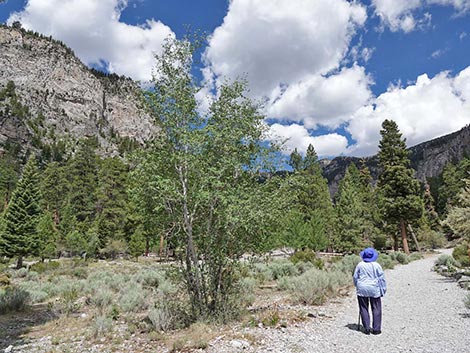 Sagebrush and Ponderosa Pine |
Overview Kyle Canyon is a good place to bird the western montane forest. Kyle Canyon Road starts in typical Mojave Desert scrub at an elevation of about 3,000 feet and climbs through the Pinyon-Juniper Woodland to a Yellow Pine Forest and then a Pine-Fir Forest mixed with Quaking Aspen at an elevation of about 8,000 feet, providing a good range of habitats, each with different species of birds and other wildlife. Other than Fletcher Spring and Stanley B Spring, there are no particular birding "hot spots" in Kyle Canyon, but there are many places to stop, enjoy the mountain habitat, and watch a few birds. Check the middle-elevation shrubland, spy on backyard feeders in town, bird the woods from the road and picnic areas, take short hikes, or climb to the summits -- there are plenty of opportunities to spot good birds in Kyle Canyon. Adventuresome birders might venture into the high country in search of higher-elevations species and small mountain meadows. |
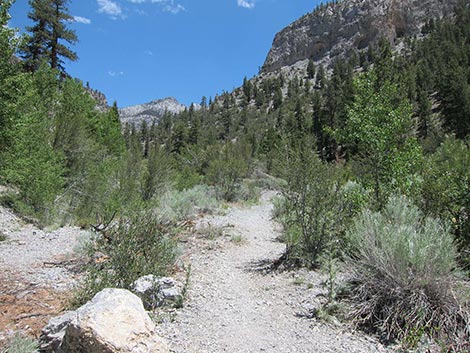 Pines, aspen, and shrubs at Trail Canyon |
Description The Spring Mountains, located northwest of town, rise from desert valleys at elevations below 2,000 ft to the summit of Mount Charleston at nearly 12,000 ft. The great range in elevation creates a great range of climate and several vegetation zones. The Spring Mountains are completely surrounded by desert, forming an island of montane habitat surrounded by a sea of desert scrub. This island of high-elevation vegetation provides habitat for montane species not found in the deserts around Las Vegas. In contrast to the desert, the mountains have a real winter, and the changing seasons and winter snowfall results in a range of birding opportunities. Kyle Canyon is one of the major canyons on the east side of Mount Charleston, and the Kyle Canyon Road provides easy access to a number of hiking and birding sites, but there are no particular hot spots for birds. The best way to bird the area is to drive the road, stopping to bird in different habitat types (be sure to pull off the road and watch the traffic), and walking the trails along the road. |
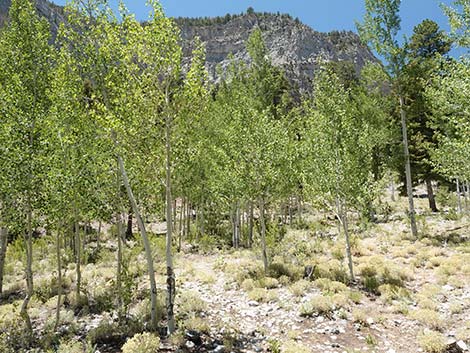 Groves of Quaking Aspen are good places to look for birds |
Kyle Canyon Road starts in typical Mojave Desert Scrub, climbs through a scrub-oak canyon into the Pinyon-Juniper Woodlands, traverses a narrow band of Yellow Pine Forest, and gets to the Pine-Fir Forest mixed with quaking aspen at elevations near 8,000 feet. Roads end in a deep canyon surrounded by towering limestone cliffs. Places to bird in Kyle Canyon include pullouts along the road in the Mojave Desert Scrub desert and Pinyon-Juniper Woodland zones, the Kyle Canyon Visitor Center in the Yellow Pine Forest zone, and the Public Library, Lodge, Picnic Area, and Trailheads in the Pine-Fir Forest zone. |
 Deer Creek Road in mid-elevation shrubland above Kyle Canyon |
Pullouts along the Road. There are a number of pullouts along the road where birders can stop, pull completely off the road, and watch and listen for birds. In the desert zone, look for House Finch, Rock Wren, and Say's Phoebe. In the pinyon-juniper zone, look for Juniper Titmouse, Pinyon Jay, Spotted Towhee, and Blue-gray Gnatcatcher. |
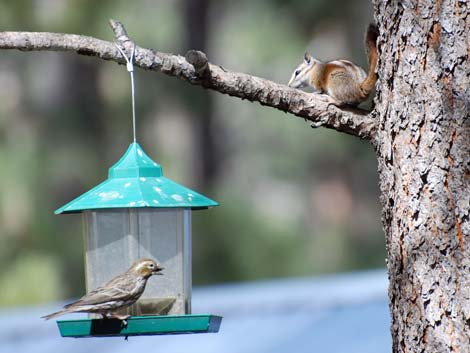 Backyard feeder near the public library |
Old Town Library Area. The public library is located in Old Town, across the street from the fire station. Check the tall trees for Band-tailed Pigeons, and walk through town checking the seed feeders for Cassin's Finch and Purple Finch, and the nectar feeders for Broad-tailed Hummingbirds, Calliope Hummingbirds, and Rufous Hummingbirds. Please respect private property. Just after dark during summer, listen for Mexican Whip-poor-will. |
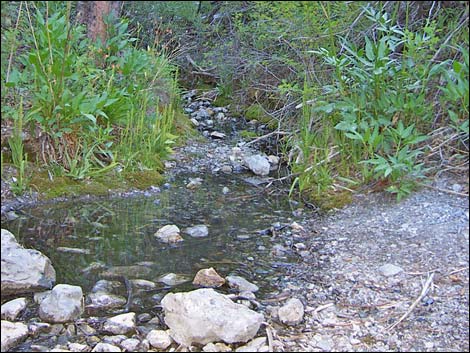 Fletcher Canyon Spring |
Fletcher Canyon Spring. Hike about 1.4 miles up Fletcher Canyon to a spring and riparian area. This is a nice hike, and the birding can be good. Keep an eye out for our Painted Restarts. For details of the hike, see Fletcher Canyon Hike. |
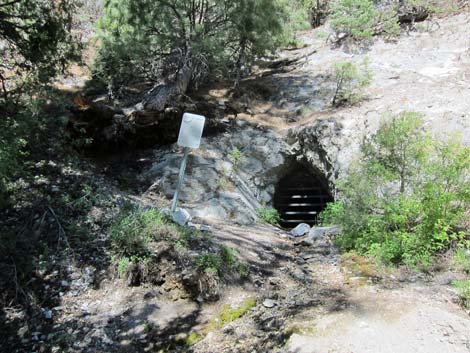 A trickle of water below mine opening at Stanley B Springs |
Stanley B Spring. The Stanley B Springs Trail runs about 1.2 miles up an old road on the north side of Kyle Canyon (forested, south-facing slopes) to an area of springs surrounded by ponderosa pine, white fir, mountain mahogany, and limestone cliffs. The main wet area, the confluence of two smaller canyons, is a good place to relax in the shade and watch birds as they come in for water. Just above the confluence in the east fork, a use-trail leads to two mines that provide habitat for forest bats (grates keep humans out), and water trickles from the lower mine. Up the west fork, a use-trail continues up the canyon past the official springs and on up into the high country. For details of the route, see Stanley B Springs Trail Hike. |
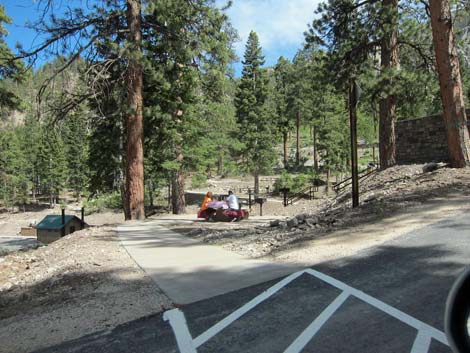 Cathedral Rock Picnic Area |
Cathedral Rock Picnic Area. The picnic area is located high in the canyon, directly below the east side of Cathedral Rock. The Pine-Fir Forest here has an open understory of wild currents and few other shrubs, plus some grasses, thistles, and a few forbs. If the picnic area is too busy, there are several trails (e.g., the Cathedral Rock Trail) that will get you away from the developed area. Look for Northern Flicker, Cassin's Finch, Red-breasted Nuthatch, Steller's Jay, Mountain Chickadee, and Clark's Nutcracker. Keep an eye out for Golden-mantled Ground Squirrels and Mount Charleston Chipmunks. The golden-mantles have a reddish-golden head, and the chipmunks have black-and-white stripes on the face. The Mt. Charleston Chipmunk, also called Palmer's Chipmunk, is a species found only here in the Spring Mountains. Kyle Canyon Lodge. The lodge is located high in the canyon, below and just east of Cathedral Rock. The Pine-Fir Forest and birding opportunities here are similar to those at Cathedral Rock Picnic Area, but at the lodge, they will serve you lunch outdoors on the porch while you do a little birding. Keep an eye out for Mount Charleston Chipmunks. |
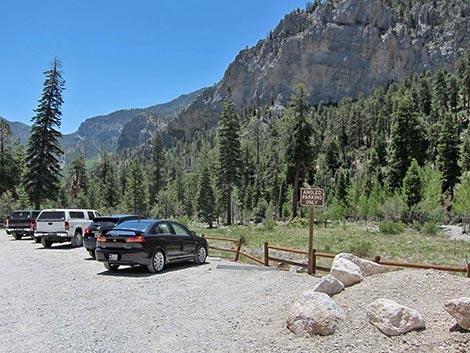 Meadow, shrubs, and trees at Mary Jane trailhead |
Mary Jane Falls Trailhead. Even though the parking area is surrounded by towering limestone cliffs, this part of the canyon is fairly open with a forest of ponderosa pines, white fir, quaking aspens, big sagebrush, and mountain mahogany. The understory is open with a few wild current and composite shrubs, plus some grasses, thistles, and a few other forbs. Look for Red-breasted Nuthatch, Pygmy Nuthatch, Steller's Jay, Mountain Chickadee, Lewis's Woodpecker, Green-tailed Towhee, Townsend's Solitaire, Cassin's Finch, Yellow-rumped Warbler, Dark-eyed Junco, and Clark's Nutcracker. |
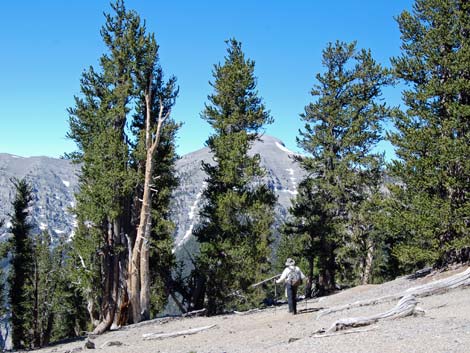 Adventuresome birders might tackle the highest elevations |
High Country. For strong and adventuresome birders, consider tackling one of the high-country trails. The South Loop Trail, North Loop Trail, and Trail Canyon Trail all lead pretty quickly to higher elevations. Consider hiking 6.1 miles, round trip, to Mummy Spring where water flows over a low cliff, forms a small meadow, and attracts birds from far and wide. Expect to see Clark's Nutcrackers and Broad-tailed Hummingbirds. |
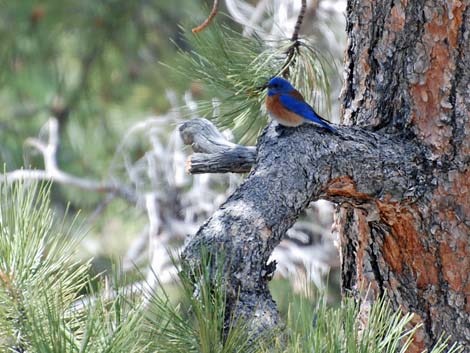 Western Bluebird in Ponderosa Pine |
Locations The end of the road in Kyle Canyon is located northwest of Las Vegas, about 60 minutes from downtown. Head out to Mt. Charleston. From the turnoff on Highway 95, drive west on Highway 157 (Kyle Canyon Road) for about 21 miles to the end of the road (Table 1, Site 0669), stopping along the way to check for birds. Spring Mountains Visitor Center (Site 0726). The Visitor Center is located about 18 miles up the Kyle Canyon from Highway 95. It is on the south side of Highway 157, about 0.6 miles beyond the intersection with Highway 158 (Deer Creek Road). Cathedral Rock Picnic Area (Site 0670). The picnic area is located just before the end of Highway 157. The Kyle Canyon Road runs up the canyon, makes a big hairpin curve and climbs back and up underneath Cathedral Rock. Just past the Cathedral Rock trailhead parking, turn right (south) into the picnic area. They charge a parking fee in the picnic area, so park outside and walk in for free. |
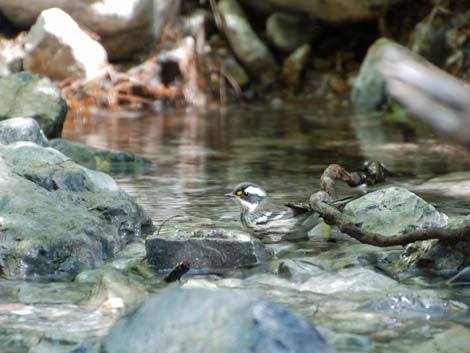 |
Kyle Canyon Lodge (Site 0669). The lodge is located at the end of Highway 157. As you come out of the turn-around at the end of the pavement, you will be looking right at the porch of the lodge. Mary Jane Falls Trailhead (Site 0541). The trailhead parking is located higher up in the canyon than the picnic area and lodge. From the Visitor Center, drive about 2 miles up the canyon to Echo Road, which veers off the main road just before the big hairpin curve. On Echo Road, drive 0.35 miles to a left turn with a sign for Mary Jane Falls. Turn left onto a dirt road and pass Echo Well Pump Station #3 (signs and chain-link fence). Drive another 0.25 miles to the end of the dirt road. |
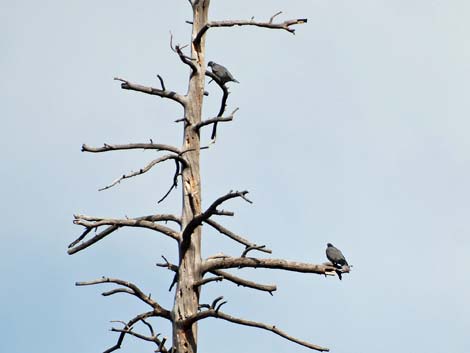 Band-tailed Pigeons |
Hours Most areas are always open. The Cathedral Rock Picnic Area is closed, and the gates are locked, around sunset. If you plan to wander off into the woods, be sure to check at fee booth about closing time (it changes during the year) so you don't return late and find your car locked in for the night. Fees Most areas are free, but they charge a "parking fee" in the Cathedral Rock picnic area. The last time I checked, I was $6 to park inside the picnic area (walk in for free). If you walk into the picnic area from the Cathedral Rock Trail parking area, walk on the road; the trail eventually loops back to the picnic area, but it makes for a long, steep route. |
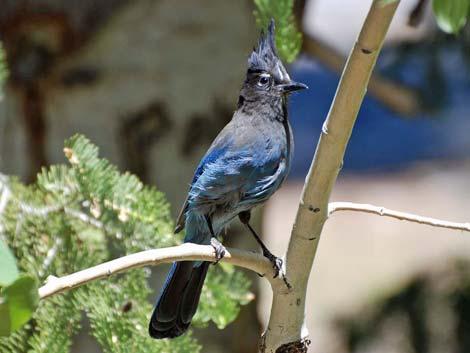 Steller's Jay |
Specialties Kyle Canyon is good for finding woodpeckers, chickadees, nuthatches, bluebirds, warblers, towhees, and jays. Keep an eye out for Northern Flicker, Lewis's Woodpecker, Clark's Nutcracker, Red-tailed Hawk, Steller's Jay, Woodhouse's Scrub-Jay, Pinyon Jay, Mountain Chickadee, Pine Siskin, Red Crossbill, Pygmy Nuthatch, White-breasted Nuthatch, Red-breasted Nuthatch, Ruby-crowned Kinglet, Townsend's Solitaire, Western Bluebird, Cassin's Finch, Purple Finch, Dark-eyed Junco, Green-tailed Towhee, Western Tanager, Townsend's Warbler, Black-throated Gray Warbler, Virginia Warbler, and Yellow-rumped Warbler. Be sure to watch for Mt. Charleston Chipmunks (Palmer's Chipmunk), an endemic species, often seen in picnic areas, and the only chipmunk at or above the yellow-pine zone. Watch for Golden-mantled Ground Squirrels too; these are only found in high-elevation places. |
Table 1. GPS Coordinates for Highway Locations (NAD27; UTM Zone 11S). Download Highway GPS Waypoints (*.gpx) file.
| Site # | Location | Latitude (°N) | Longitude (°W) | UTM Easting | UTM Northing | Elevation (feet) | Verified |
|---|---|---|---|---|---|---|---|
| 0541 | Mary Jane Falls trailhead | 36.2671 | 115.6615 | 620230 | 4014205 | 7,825 | Yes |
| 0669 | Mt. Charleston Lodge | 36.2576 | 115.6437 | 621848 | 4013177 | 7,630 | Yes |
| 0670 | Cathedral Rock picnic area | 36.2564 | 115.6441 | 621812 | 4013040 | 7,650 | Yes |
| 0726 | Spring Mts Visitor Center | 36.2630 | 115.6132 | 624580 | 4013810 | 6,932 | Yes |
Happy birding! All distances, elevations, and other facts are approximate.
![]() ; Last updated 240322
; Last updated 240322
| Birding Around Las Vegas | Southern Nevada Birds | Guide Service | Copyright, Conditions, Disclaimer | Home |